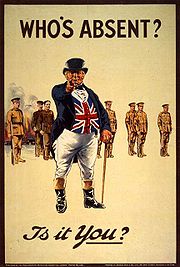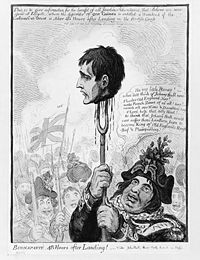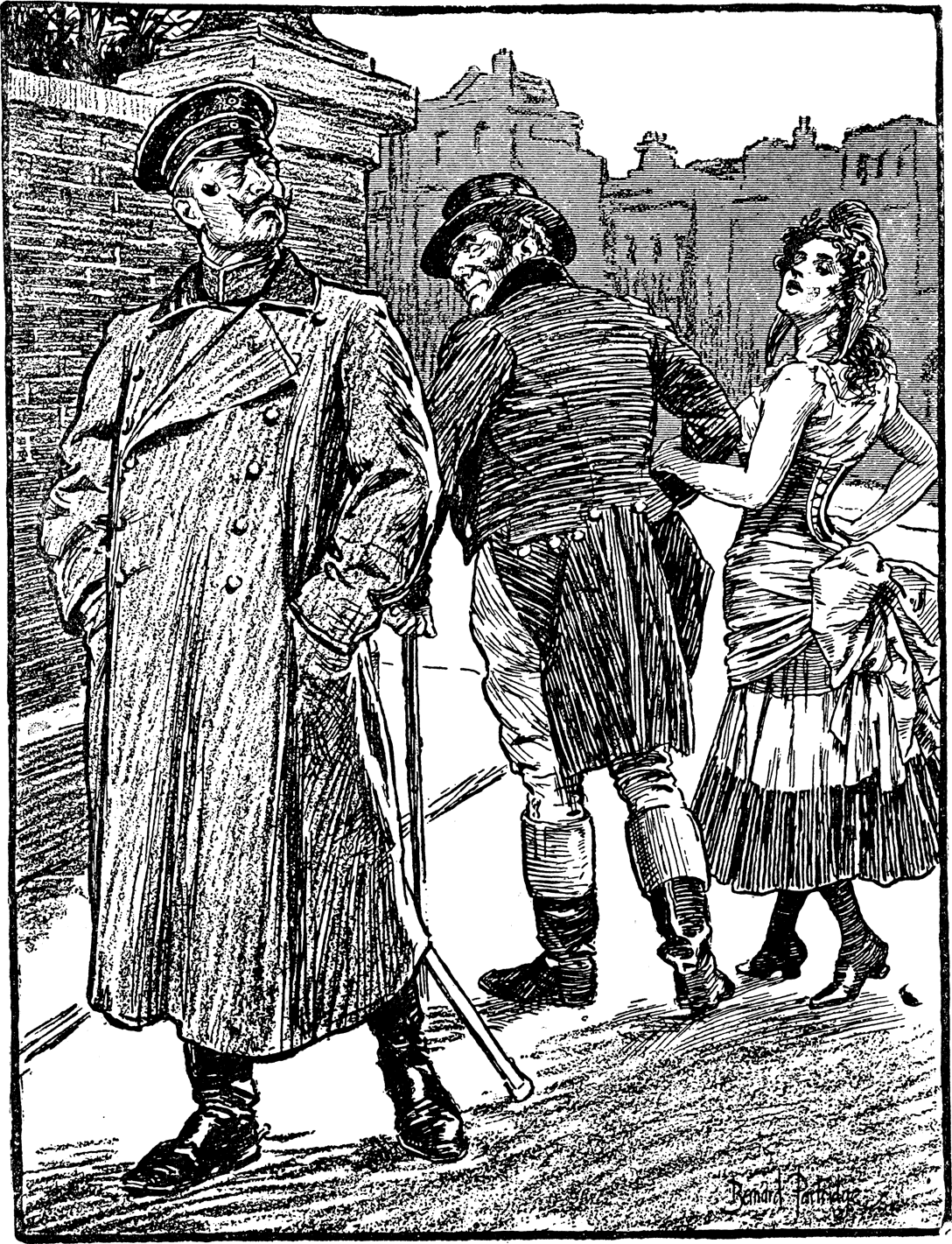
John Bull
Encyclopedia




National personification
A national personification is an anthropomorphization of a nation or its people; it can appear in both editorial cartoons and propaganda.Some early personifications in the Western world tended to be national manifestations of the majestic wisdom and war goddess Minerva/Athena, and often took the...
of Britain
United Kingdom
The United Kingdom of Great Britain and Northern IrelandIn the United Kingdom and Dependencies, other languages have been officially recognised as legitimate autochthonous languages under the European Charter for Regional or Minority Languages...
in general and England
England
England is a country that is part of the United Kingdom. It shares land borders with Scotland to the north and Wales to the west; the Irish Sea is to the north west, the Celtic Sea to the south west, with the North Sea to the east and the English Channel to the south separating it from continental...
in particular, especially in political cartoons and similar graphic works. He is usually depicted as a stout, middle-aged man, often wearing a Union Flag
Union Flag
The Union Flag, also known as the Union Jack, is the flag of the United Kingdom. It retains an official or semi-official status in some Commonwealth Realms; for example, it is known as the Royal Union Flag in Canada. It is also used as an official flag in some of the smaller British overseas...
waistcoat.
Origin
John Bull originated in the creation of Dr. John ArbuthnotJohn Arbuthnot
John Arbuthnot, often known simply as Dr. Arbuthnot, , was a physician, satirist and polymath in London...
in 1712, and was popularised first by British print makers and then overseas by illustrators and writers such as American cartoonist Thomas Nast
Thomas Nast
Thomas Nast was a German-born American caricaturist and editorial cartoonist who is considered to be the "Father of the American Cartoon". He was the scourge of Boss Tweed and the Tammany Hall machine...
and Irish writer George Bernard Shaw
George Bernard Shaw
George Bernard Shaw was an Irish playwright and a co-founder of the London School of Economics. Although his first profitable writing was music and literary criticism, in which capacity he wrote many highly articulate pieces of journalism, his main talent was for drama, and he wrote more than 60...
, author of John Bull's Other Island
John Bull's Other Island
John Bull's Other Island is a comedy about Ireland, written by G. Bernard Shaw in 1904. Shaw himself was born in Dublin, yet this is the only play of his where he thematically returned to his homeland....
. He is sometimes used to refer to the whole of the United Kingdom, but has not been accepted in Scotland
Scotland
Scotland is a country that is part of the United Kingdom. Occupying the northern third of the island of Great Britain, it shares a border with England to the south and is bounded by the North Sea to the east, the Atlantic Ocean to the north and west, and the North Channel and Irish Sea to the...
or Wales
Wales
Wales is a country that is part of the United Kingdom and the island of Great Britain, bordered by England to its east and the Atlantic Ocean and Irish Sea to its west. It has a population of three million, and a total area of 20,779 km²...
because he is viewed there as English rather than British. Britannia
Britannia
Britannia is an ancient term for Great Britain, and also a female personification of the island. The name is Latin, and derives from the Greek form Prettanike or Brettaniai, which originally designated a collection of islands with individual names, including Albion or Great Britain. However, by the...
, or a lion
Lion
The lion is one of the four big cats in the genus Panthera, and a member of the family Felidae. With some males exceeding 250 kg in weight, it is the second-largest living cat after the tiger...
, is therefore used as an alternative in some editorial cartoon
Editorial cartoon
An editorial cartoon, also known as a political cartoon, is an illustration containing a commentary that usually relates to current events or personalities....
s. Although embraced by Unionists, Bull is rejected by nationalists
Irish nationalism
Irish nationalism manifests itself in political and social movements and in sentiment inspired by a love for Irish culture, language and history, and as a sense of pride in Ireland and in the Irish people...
in Northern Ireland
Northern Ireland
Northern Ireland is one of the four countries of the United Kingdom. Situated in the north-east of the island of Ireland, it shares a border with the Republic of Ireland to the south and west...
as well.
As a literary figure, John Bull is well-intentioned, frustrated, full of common sense, and entirely of native country stock. Unlike Uncle Sam
Uncle Sam
Uncle Sam is a common national personification of the American government originally used during the War of 1812. He is depicted as a stern elderly man with white hair and a goatee beard...
later, he is not a figure of authority but rather a yeoman
Yeoman
Yeoman refers chiefly to a free man owning his own farm, especially from the Elizabethan era to the 17th century. Work requiring a great deal of effort or labor, such as would be done by a yeoman farmer, came to be described as "yeoman's work"...
who prefers his small beer and domestic peace, possessed of neither patriarchal power nor heroic defiance. Arbuthnot
John Arbuthnot
John Arbuthnot, often known simply as Dr. Arbuthnot, , was a physician, satirist and polymath in London...
provided him with a sister named Peg (Scotland), and a traditional adversary in Louis Baboon (the House of Bourbon
House of Bourbon
The House of Bourbon is a European royal house, a branch of the Capetian dynasty . Bourbon kings first ruled Navarre and France in the 16th century. By the 18th century, members of the Bourbon dynasty also held thrones in Spain, Naples, Sicily, and Parma...
in France
France
The French Republic , The French Republic , The French Republic , (commonly known as France , is a unitary semi-presidential republic in Western Europe with several overseas territories and islands located on other continents and in the Indian, Pacific, and Atlantic oceans. Metropolitan France...
). Peg continued in pictorial art beyond the 18th century, but the other figures associated with the original tableau dropped away.
Portrayal
Bull is usually portrayed as a stout, portly man in a tailcoatTailcoat
A tailcoat is a coat with the front of the skirt cut away, so as to leave only the rear section of the skirt, known as the tails. The historical reason coats were cut this way was to make it easier for the wearer to ride a horse, but over the years tailcoats of varying types have evolved into forms...
with light-coloured breeches
Breeches
Breeches are an item of clothing covering the body from the waist down, with separate coverings for each leg, usually stopping just below the knee, though in some cases reaching to the ankles...
and a top hat which by its shallow crown indicates its middle class identity. During the Georgian period his waistcoat
Waistcoat
A waistcoat or vest is a sleeveless upper-body garment worn over a dress shirt and necktie and below a coat as a part of most men's formal wear, and as the third piece of the three-piece male business suit.-Characteristics and use:...
is red and/or his tailcoat is royal blue which, together with his buff or white breeches, can thus refer to a greater or lesser extent to the 'blue and buff' scheme used by supporters of Whig politics which is part of what John Arbuthnot wished to deride when he invented the character. By the twentieth century however his waistcoat nearly always depicts a Union Flag
Union Flag
The Union Flag, also known as the Union Jack, is the flag of the United Kingdom. It retains an official or semi-official status in some Commonwealth Realms; for example, it is known as the Royal Union Flag in Canada. It is also used as an official flag in some of the smaller British overseas...
, and his coat is generally dark blue (but otherwise still echoing the fashions of the Regency period). He also wears a low topper
Top hat
A top hat, beaver hat, high hat silk hat, cylinder hat, chimney pot hat or stove pipe hat is a tall, flat-crowned, broad-brimmed hat, predominantly worn from the latter part of the 18th to the middle of the 20th century...
(sometimes called a John Bull topper) on his head and is often accompanied by a bulldog
Bulldog
Bulldog is the name for a breed of dog commonly referred to as the English Bulldog. Other Bulldog breeds include the American Bulldog, Olde English Bulldogge and the French Bulldog. The Bulldog is a muscular heavy dog with a wrinkled face and a distinctive pushed-in nose...
. John Bull has been used in a variety of different ad campaigns over the years, and is a common sight in British editorial cartoons of the 19th and early 20th centuries.
Washington Irving
Washington Irving
Washington Irving was an American author, essayist, biographer and historian of the early 19th century. He was best known for his short stories "The Legend of Sleepy Hollow" and "Rip Van Winkle", both of which appear in his book The Sketch Book of Geoffrey Crayon, Gent. His historical works...
described him in his chapter entitled "John Bull" from The Sketch Book:
- "...[A] plain, downright, matter-of-fact fellow, with much less of poetry about him than rich prose. There is little of romance in his nature, but a vast deal of a strong natural feeling. He excels in humour more than in wit; is jolly rather than gay; melancholy rather than morose; can easily be moved to a sudden tear or surprised into a broad laugh; but he loathes sentiment and has no turn for light pleasantry. He is a boon companion, if you allow him to have his humour and to talk about himself; and he will stand by a friend in a quarrel with life and purse, however soundly he may be cudgelled."
The cartoon image of stolid, stocky, conservative and well-meaning John Bull, dressed like an English country squire
Squire
The English word squire is a shortened version of the word Esquire, from the Old French , itself derived from the Late Latin , in medieval or Old English a scutifer. The Classical Latin equivalent was , "arms bearer"...
, sometimes explicitly contrasted with the conventionalised scrawny, French revolutionary sans-culottes
Sans-culottes
In the French Revolution, the sans-culottes were the radical militants of the lower classes, typically urban laborers. Though ill-clad and ill-equipped, they made up the bulk of the Revolutionary army during the early years of the French Revolutionary Wars...
Jacobin
Jacobin (politics)
A Jacobin , in the context of the French Revolution, was a member of the Jacobin Club, a revolutionary far-left political movement. The Jacobin Club was the most famous political club of the French Revolution. So called from the Dominican convent where they originally met, in the Rue St. Jacques ,...
, was developed from about 1790 by British satirical
Satire
Satire is primarily a literary genre or form, although in practice it can also be found in the graphic and performing arts. In satire, vices, follies, abuses, and shortcomings are held up to ridicule, ideally with the intent of shaming individuals, and society itself, into improvement...
artists James Gillray
James Gillray
James Gillray , was a British caricaturist and printmaker famous for his etched political and social satires, mainly published between 1792 and 1810.- Early life :He was born in Chelsea...
, Thomas Rowlandson
Thomas Rowlandson
Thomas Rowlandson was an English artist and caricaturist.- Biography :Rowlandson was born in Old Jewry, in the City of London. He was the son of a tradesman or city merchant. On leaving school he became a student at the Royal Academy...
and George Cruikshank
George Cruikshank
George Cruikshank was a British caricaturist and book illustrator, praised as the "modern Hogarth" during his life. His book illustrations for his friend Charles Dickens, and many other authors, reached an international audience.-Early life:Cruikshank was born in London...
. (An earlier national personification was Sir Roger de Coverley, from The Spectator (1711)
The Spectator (1711)
The Spectator was a daily publication of 1711–12, founded by Joseph Addison and Richard Steele in England after they met at Charterhouse School. Eustace Budgell, a cousin of Addison's, also contributed to the publication. Each 'paper', or 'number', was approximately 2,500 words long, and the...
.)
In 1966, The Times
The Times
The Times is a British daily national newspaper, first published in London in 1785 under the title The Daily Universal Register . The Times and its sister paper The Sunday Times are published by Times Newspapers Limited, a subsidiary since 1981 of News International...
, criticising the Unionist government of Northern Ireland, famously branded the province "John Bull's Political Slum".
In a suffragette
Suffragette
"Suffragette" is a term coined by the Daily Mail newspaper as a derogatory label for members of the late 19th and early 20th century movement for women's suffrage in the United Kingdom, in particular members of the Women's Social and Political Union...
cartoon of 1912, John Bull is portrayed looking out of the window of a house over whose door the sign says "Franchise Villa", while his wife knocks on the door, with the accompanying text:
John Bull: "How long are you going on making that noise outside?"
Mrs Bull: "Till you let me in, John!"
Increasingly through the early twentieth century, John Bull became seen as not particularly representative of 'the common man', and during the First World War this function was largely taken over by the figure of Tommy Atkins
Tommy Atkins
Tommy Atkins is a term for a common soldier in the British Army that was already well established in the 19th century, but is particularly associated with World War I. It can be used as a term of reference, or as a form of address. German soldiers would call out to "Tommy" across no man's land if...
.
John Bull's surname is also reminiscent of the alleged fondness of the English for beef
Beef
Beef is the culinary name for meat from bovines, especially domestic cattle. Beef can be harvested from cows, bulls, heifers or steers. It is one of the principal meats used in the cuisine of the Middle East , Australia, Argentina, Brazil, Europe and the United States, and is also important in...
, reflected in the French nickname for English people, les rosbifs (the "Roast Beefs").
A typical John Bull Englishman is referenced in Margaret Fuller's Summer on the Lakes, in 1843 in Chapter 2: "Murray's travels I read, and was charmed by their accuracy and clear broad tone. He is the only Englishman that seems to have traversed these regions, as man, simply, not as John Bull."
In fiction
In the Black DossierThe League of Extraordinary Gentlemen: Black Dossier
The League of Extraordinary Gentlemen: Black Dossier is an original graphic novel in the comic book series The League of Extraordinary Gentlemen, written by Alan Moore and illustrated by Kevin O'Neill. It was the last volume of the series to be published by DC Comics. Although the third book to be...
by Alan Moore
Alan Moore
Alan Oswald Moore is an English writer primarily known for his work in comic books, a medium where he has produced a number of critically acclaimed and popular series, including Watchmen, V for Vendetta, and From Hell...
, John Knight - father of Emma Peel
Emma Peel
Emma Peel was a fictional spy played by Diana Rigg in the British 1960s adventure television series The Avengers. She was born Emma Knight, the daughter of an industrialist, Sir John Knight.-Casting:...
- boasts that he and Bulldog Drummond
Bulldog Drummond
Bulldog Drummond is a British fictional character, created by "Sapper", a pseudonym of Herman Cyril McNeile , and the hero of a series of novels published from 1920 to 1954.- Drummond :...
are the 'modern' sources of the personification of John Bull.
See also
- Symbols of the United Kingdom of Great Britain and Northern Ireland
- Terminology of the British Isles
- John Bull's Other IslandJohn Bull's Other IslandJohn Bull's Other Island is a comedy about Ireland, written by G. Bernard Shaw in 1904. Shaw himself was born in Dublin, yet this is the only play of his where he thematically returned to his homeland....
- SawneySawneySandie/y or Sawney was an English nickname for a Scotsman, now obsolete, and playing much the same linguistic role that "Jock" does now. Variations included Sanders and Sannock. The name is a Lowland Scots diminutive of the favourite Scottish first name Alexander from the last two syllables...
- Uncle SamUncle SamUncle Sam is a common national personification of the American government originally used during the War of 1812. He is depicted as a stern elderly man with white hair and a goatee beard...

